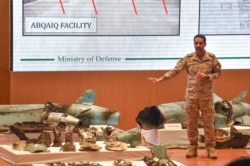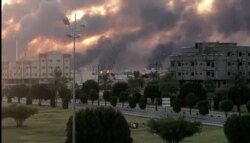(Pentagon Correspondent Carla Babb, National Security Correspondent Jeff Seldin and Katherine Ahn of VOA’s Persian Service contributed to this report.)
President Donald Trump said Wednesday the U.S. has “many options” in addition to military strikes to respond to Iran’s missile and drone attacks that knocked out half of Saudi Arabia’s oil production last weekend.
“We’re in a very strong position,” Trump told reporters on an airport tarmac in California as he headed to a political fundraiser. In Saudi Arabia, Secretary of State Mike Pompeo accused Iran of carrying out an “act of war” in the attacks.
Trump’s statement came hours after he said he is “substantially” increasing economic sanctions against Iran in the wake of the oil field attacks that Washington says were launched by Tehran.
Trump, on Twitter, said he had directed Treasury Secretary Steven Mnuchin to stiffen existing sanctions against Iran that American officials say have already hobbled its economy, but gave no details of the new penalties. Trump said the specifics of the sanctions would be announced within 48 hours.
The Trump administration does not appear to want an all-out war with Iran but also wants to re-establish deterrence in the region, Middle East Institute security analyst Bilal Saab told VOA Persian in an interview.
“To balance between these two (goals) will be a challenge,” Saab said. “In order to send a message to the Iranians not to do this again, and at the same time manage the situation and control escalation, I think covert options should be on the table.”
Trump’s sanctions order came as Pompeo met with Saudi officials in Jeddah on how to respond to the attacks that at least temporarily cut the Saudis’ daily oil production by 5.7 million barrels, nearly 6% of the global oil supply.
“The U.S. stands with Saudi Arabia and supports its right to defend itself,” Pompeo posted on Twitter after the talks. “The Iranian regime’s threatening behavior will not be tolerated.”
At a news conference, Saudi officials displayed what they said were remnants of 25 unmanned Iranian Delta Wing drones and "Ya-Ali" cruise missiles they have retrieved from the oil facilities that were attacked.
"The attack was launched from the north and unquestionably sponsored by Iran. The evidence ... that you have seen in front of you, makes this undeniable," Defense Ministry spokesman Col. Turki al-Malki said.
Iran's state-run IRNA news agency reported Wednesday that the government sent a diplomatic note to the U.S. denying involvement in the Saudi oil field attacks and warned that if any actions are taken against Iran, it will respond immediately.
Shortly after the middle-of-the-night attacks last Saturday, Iranian-backed Houthi rebels in Yemen claimed responsibility and reiterated their claim on Wednesday. A Houthi spokesman also threatened to target the United Arab Emirates for its support of the Saudi-led operations inside Yemen.
“One operation will cost you a lot,” the Houthi spokesman vowed.
But U.S. and Saudi officials say the available evidence shows it is not possible that oil field attacks were launched from Yemen.
"Our working assumption is that this did not come from Yemen or Iraq," a U.S. defense official told VOA Tuesday, adding that a U.S. forensic team is on the ground working with the Saudis to examine the remnants of the missiles.
"We think that evidence will be compelling," the official added.
A 'warning' to Saudi Arabia
Iranian President Hassan Rouhani said Wednesday that Yemenis carried out the attack as a "warning" to Saudi Arabia over its involvement leading a coalition fighting the Houthis. Human rights groups have criticized Saudi-led airstrikes for devastating civilian areas and worsening what is one of the world's worst humanitarian crises.
Rouhani said the Yemenis "did not hit hospitals, they did not hit schools or the Sanaa bazaar," and that the Saudis should "learn the lesson from this warning."
The Iranian president did not directly speak to allegations his government was responsible for the strikes, but said he does not want conflict in the region.
U.S. Chairman of the Joint Chiefs of Staff Joseph Dunford told reporters in London that Saturday’s attack looked different from those previously carried out by the Houthi rebels.
He said the United States does not have any overhead imagery of the attacks, and that it will let the Saudis make their own assessment of what happened.
Meanwhile, Prince Abdulaziz bin Salman, Saudi energy minister, announced Tuesday that half of the oil production cut by the attacks has been restored and that the kingdom expects to be producing 11 million barrels a day by the end of September, compared to 9.6 million before the attacks.















